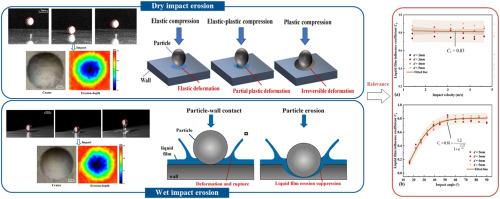Study on the multifactorial influence of particle impact parameters on erosion characteristics under dry/wet wall conditions
IF 6.1
1区 工程技术
Q1 ENGINEERING, MECHANICAL
引用次数: 0
Abstract
Particle impact erosion is prevalent in engineering fields such as energy systems and chemical engineering, yet the interactions between liquid films and particles under wet impact conditions remain poorly understood. In this study, the effects of particle diameter (2–5 mm), impact velocity (1.4–4.6 m/s for normal impacts and 3 m/s for oblique impacts), and impact angle on erosion behaviour under both dry and wet conditions are examined. The results show that, under dry conditions, the erosion depth was linearly related to particle diameter and velocity and reached 153.8 μm for 4 mm particles at 4.64 m/s, whereas it reached 76.6 μm for 2 mm particles. The erosion volume increased quadratically with velocity and peaked at an impact angle of approximately 80°. Under wet conditions (with a film thickness of 300 μm and a viscosity of 195 mPa s), the liquid film significantly reduced erosion, and the erosion volume growth rates exhibited a distinct transition at 3.4 m/s. A functional model was developed to quantify the effects of the film on the velocity and angle. These findings offer a theoretical foundation for erosion-resistant system design.

干湿壁面条件下颗粒冲击参数对侵蚀特性的多因素影响研究
颗粒冲击侵蚀在能源系统和化学工程等工程领域非常普遍,但在湿冲击条件下,液体膜和颗粒之间的相互作用仍然知之甚少。在这项研究中,研究了颗粒直径(2-5毫米)、冲击速度(正常冲击为1.4-4.6米/秒,倾斜冲击为3米/秒)和冲击角度对干湿条件下侵蚀行为的影响。结果表明:在干燥条件下,侵蚀深度与颗粒直径和速度呈线性关系,在4.64 m/s速度下,4 mm颗粒的侵蚀深度达到153.8 μm, 2 mm颗粒的侵蚀深度达到76.6 μm;冲蚀体积随速度呈二次增长,在冲蚀角约为80°时达到峰值。在湿态条件下(膜厚为300 μm,黏度为195 mPa s),液膜明显减少了侵蚀,侵蚀体积增长速率在3.4 m/s时发生了明显的转变。建立了一个函数模型来量化薄膜对速度和角度的影响。这些发现为抗侵蚀系统的设计提供了理论基础。
本文章由计算机程序翻译,如有差异,请以英文原文为准。
求助全文
约1分钟内获得全文
求助全文
来源期刊

Wear
工程技术-材料科学:综合
CiteScore
8.80
自引率
8.00%
发文量
280
审稿时长
47 days
期刊介绍:
Wear journal is dedicated to the advancement of basic and applied knowledge concerning the nature of wear of materials. Broadly, topics of interest range from development of fundamental understanding of the mechanisms of wear to innovative solutions to practical engineering problems. Authors of experimental studies are expected to comment on the repeatability of the data, and whenever possible, conduct multiple measurements under similar testing conditions. Further, Wear embraces the highest standards of professional ethics, and the detection of matching content, either in written or graphical form, from other publications by the current authors or by others, may result in rejection.
 求助内容:
求助内容: 应助结果提醒方式:
应助结果提醒方式:


